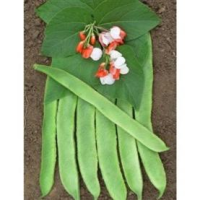Runner Bean Painted Lady
Runner Bean Painted Lady
Packet Size: 24 seeds
Couldn't load pickup availability
Painted Lady is a real classic – first written about back in the 1880s, and still going strong today. It’s easy to see why: the plants are prolific, the pods are beautifully tender, and the flavour is a real standout. It’s a personal favourite here.
The red and white bi-colour flowers are a treat too – I’ve even heard it called the York and Lancaster bean, though I’m not sure how official that is. Either way, it’s a lovely variety to grow, and the bees agree – it’s listed by the RHS as great for pollinators.
SOW: wait for mid-spring, after frost danger has passed. We like to start runners in pots (seed depth 2.5-5cm) & plant out when they show signs of wanting to climb after hardening off. You can plant them in situ but put your canes in place first! They like rich soil so if you are able to dig in organic matter early in the spring the beans will appreciate the extra boost.
GROW: Runners like a cane each about 20cm apart, you may need to encourage them to twine but they soon get the hang of it. You can pinch out the first growing tip when 25cm high to encourage more bushy growth. They are insect pollinated – the insects prefer shelter from wind. Depending on the growing conditions Painted cropping will start in about 12-14 weeks. They like to be watered at the base in dry weather.
ENJOY: the flowers are loved by pollinators, and you will love the beans! We like to pick our beans when they are young. Fresh beans to the plate are a flavour to savour – I have been known to eat a bowl full with sprinkle of grated cheese on top! All Runner Beans freeze very well – slice (blanche if you can) and bag into meal sized amounts.
WILDLIFE FRIENDLY
- Runner bean flowers are a magnet for bumblebees, especially long-tongued species like Buff-tailed and White-tailed Bumblebees, which are skilled at reaching their nectar.
- They also attract honeybees and various solitary bees, helping boost pollination and bean yields.
- Hoverflies visit the flowers for nectar, while their larvae help control aphid populations in your garden.
- Leaves and stems can host beneficial predatory insects like ladybirds and parasitic wasps that keep pests in check.
- Birds such as sparrows and finches may feed on fallen beans or seeds late in the season, supporting local wildlife food chains.

Collapsible content
Sowing
- Apr
- May
- Jun
Harvesting / Flowering
- Jul
- Aug
- Sep

